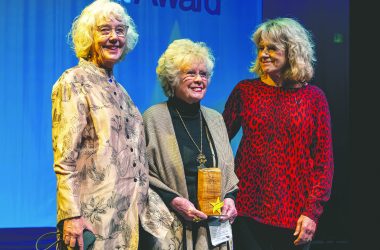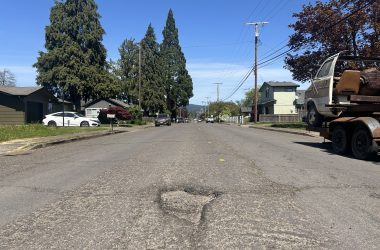 Photos by Dana Merryday/The ChronicleA major life moment – handing over the keys, even during a downpour.
Photos by Dana Merryday/The ChronicleA major life moment – handing over the keys, even during a downpour.
There were mixed emotions at the Cottage Village’s Open House last Friday. The ceremony was a celebration, a housewarming, and dedication all at once for nine tiny homes, completed and ready for residents at the East Madison Avenue village site.
There was concern expressed that while new Cottage Villagers were overcoming tremendous obstacles and achieving stable housing, this event was occurring against a backdrop of Lane County residents who lost their homes to the fires that have ravaged the McKenzie River Valley. Smoke from those fires and uncertain conditions caused Cottage Village’s Open House, to be moved to last Friday.
Speakers stepped to the mic early as the sky portended rain. No one present would complain about this much-needed precipitation. Besides helping subdue the fires and cleanse the air, rain was also a sign of blessing. A good omen. In the Bible rain is, with the possible exception of the Genesis floods, nearly always portrayed as a sign of a good thing. If the drops didn’t hold off until everyone had their say we must excuse them. The new moon the night before provided another auspicious beginning for the Cottage Village, ushering in Rosh Hashanah, the Jewish New Year.
Dan Bryant, executive director of Square One Villages, welcomed the assembled guests and stated, “We finally have some good news, with pandemics and fires, to be able to celebrate this accomplishment of a solution for the crisis of being homeless. This village is an idea whose time has come.”
Bryant went on to explain that Cottage Village was the third village the organization has guided into existence. The first was Opportunity Village, providing transitional housing. That was followed by Emerald Village Eugene, on which Cottage Village was modeled. Three more villages are in the planning stages.
Square One’s board president, Kitty Piercy, a former Eugene mayor, expressed how excited she was to be in Cottage Grove. She praised the efforts of the local Grovers who sought a solution to the housing shortage in this rural area. “I know as mayor we tried many things to address this problem, this is one that really worked, the tiny village.”
Bruce Kelsh, current chair of the Cottage Village Coalition, shared his joy at seeing the nearly four-year project so near completion. He pondered the long path it had followed, recognizing members of First Presbyterian Cottage Grove’s Earth and Social Justice Committee, Joyce Cameron, Cindy Sharp, Susan Johnson and Valeria Mainwald Clarke (also a neighbor to the village), who looked for ways to address homelessness. They stayed with the campaign through thick and thin. Kelsh thanked the Presbyterian Women’s Association for its $100,000 grant, giving the group its initial shot in the arm to begin building. Kelsh added that the village concept not only addresses homelessness but also loneliness. “Cottage Village provides safe, stable, affordable housing in a self-governed community setting,” he said.
 A peek inside one of the tiny homes, with a view of the kitchen and loft.
A peek inside one of the tiny homes, with a view of the kitchen and loft.
County commissioner Pat Farr spoke on behalf of our East Lane District 5 commissioner, Heather Buch. She was assisting fire efforts. Farr represented the Lane County Commissioners who granted $500,000 to Cottage Village. “This village is an innovative solution and will be a national landmark. People will be coming here to see how it was done. We need to do this at least ten more times in the next five years,” Farr concluded.
Cottage Grove Mayor Jeff Gowing said, “We are excited to see this construction come to a close and to be able to move some people in. We have a housing crisis in this town and this project along with the veteran homes being constructed by the American Legion Hall will help to bring some good people into housing.”
Later, following his formal remarks, Gowing commented that there was some initial opposition at the beginning of this project. “While most folks agree we need such housing, no one wants it in their backyard. Once this is done people will be better able to see what this type of housing is and that it is a good thing. With people being priced out on rent we need more housing like this.”
Other guests included Senator Floyd Prozanski, former Lane County commissioners Cindy Weeldreyer and Tony Corcoran, city councilor Kenneth Michael Roberts, interested Cottage Grovers, housing advocates from Square One, and other organizations.
Bryant recognized other major contributors to the project: Meyer Memorial Trust, Edwards Mother Earth Foundation, City of Cottage Grove, King Estates, Tom & Kris Bowerman, Oregon Community Foundation, and many other donors large and small.
Probably one of the most joyous in attendance was Fawn Love, who was presented with the key to her tiny house, a gift basket from First Presbyterian (Cottage Grove) and a housewarming gift of a quilt made by Sisters in Stitches (First Baptist Eugene). After accepting her key and gifts she expressed her gratitude. “Bless those who worked so hard to make this happen. This key in my pocket means so much. When you are struggling it seems like you will never get a place and it is easy to give up. I look forward to helping this community grow and to help it run. I am looking forward to having neighbors who I could run next door to borrow a cup of sugar or help them if they needed it,” Love said.
Attendees were invited to look into several of the units. In the afternoon members of the public arrived for prearranged tours, spaced out following COVID-19 guidelines.
Before and after the dedication I had a chance to visit with staff from the Square One organization.
Possibly the most hands-on were carpenters Gabe Casteel and Conner Anderson. They both have been with this project from the beginning of construction and put their loving care into each tiny house. Anderson explained how working with the project has been a unique experience. “Since it is a nonprofit, there is not a lot of money available. For us it is cooperation on the best levels. Most of the tools we use are our own. We both studied and got our Oregon CCB licenses. The shop that will eventually become the village community center lets us have space to do our own work to help us get by. I am a furniture maker and Gabe does welding.”
Gabe and Conner let me know that the designs for the tiny homes were donated by the architects who developed them to help solve the affordable housing shortage.
“We have completed nine units using two different floor plans. One has 192 square foot footprint plus 88-square-feet loft space, the other is 284-square-feet with 116-square-feet of loft. There are foundations poured and ready for building the remaining four units. We’ll use two different plans with slightly more room for those,” Anderson added.
Dana Smith, construction manager, told me by working with this development she hopes to take some ideas back to her community of Silverton. “I am on the city council and we are looking at the same issues of housing. This is an opportunity to use what I am learning to educate back home and help establish something similar there.”
 Much of the landscaping around the homes was purposefully left incomplete so that new residents would be able to help pick the foliage and participate in the planting.
Much of the landscaping around the homes was purposefully left incomplete so that new residents would be able to help pick the foliage and participate in the planting.
Andrew Heben, project manager, said that not finishing the landscaping was intentional. “We plan to have the residents help us with that and have them develop how the common space should look. And they will have the ultimate responsibility of maintaining it.”
On the Village site, there is a large central area covered with a black plastic grid. This product is called “grass pave.” This underlayment rests on a gravel bed which allows this area to be used as a lawn and support emergency vehicles allowing them to turn around. This creates green space on this limited site. A small pond will catch water runoff and allow it to be redirected. These innovations reflect thoughtful use of a space in order to house many people as possible.
Housing in the Cottage Village is a stepping stone to transition out of homelessness or marginal housing into a better situation. Residents pay a “deposit” of $500 that they can cash out as a starter fund when they leave.
The four foundations without houses are waiing for additional money to come in for their construction costs. Here is a chance for you to be a hero. Small donations add up and you can make a contribution to help make those homes a reality. Go to Square One’s website squareonevillages.org/cvc or donate by mail, making checks payable to: Square One Villages (please specify Cottage Village), 15 N. Polk Street, Eugene, OR 97402. $40,000 will pay for an entire house. Every donation will help this dream come true.
This success story shows that if you have the vision and are willing to see it through, it can become a reality. It takes a village to build a village. Thank you to all who have had a hand it this noble undertaking! Oh, and happy housewarming Cottage Village!
Email: [email protected]








